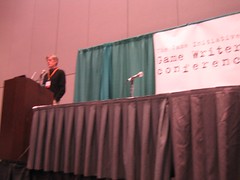26 October 2005, Texas, Austin, Austin Game Conference
//********** session summary****************
The Language of Games
Somebody, somewhere, invented the closeup, the fade, the dissolve. These techniques have contributed to the language of film. We're inventing a new language now – the language of games. This session takes a look at examples of this emerging language - and what it means for game writers.
- Hal Barwood, Designer/Writer, Finite Arts
*******************************************
//MY NOTES:
Barwood giving a historical view, starting out with the history of movies.
Fireman movie: the use of cuts.
A space odessey
Wizard of Oz: screen direction.
Lord of the rings. Gullum gollumising, how he faces when he is different persons. Facing left and right. Two persons having a conversation by use of screen direction.
Narrative flow
Pictorial grammar of games.
3d cameras...
Agenda:
Plot
Shows traditinal story arc as ppt.
Shows picture from starwars ep IV. The fatal flaw of the death star.
Shows picture of narrative arc of a game, looks like a saw.
Repetition being a major feature of game play
Games lack pace, movies driven by story, games driven by players.
Referring to Flow (cszi.... Well the name)
ESM "experiende sampling method"
Ppl happiest when strained to limit
Now shoving the traditional flow arc.
Difficulty frustration ideal boredom.
Plot. Showed 4 blobs.
Full throttle: linear plot
Manhole: didnt work....
What works is uordered plots.
- Sandbox games
- Chonicles of events
Topiary plots...
Gates around story nodes...
Advice on plot: keep them simple
Have the story in 8 pieces.
The rod as a meeter
Progress meeters: game equivalent of foreshadowing
Basis for a story must be explained… plot unfold from premise
"Sly Cooper"
"Spider man" - intrusive interface
"God of War" - intrusive interface
In games we loose ourselves in playing not in the story
The peaks of the flow are often bossfights.
Bossmonsters define the acts of a game: climatic moments of stress and reward.
Infernal Machine, indiana jones, roboss 1999
Boss monsters characerisics
- Difficult
- Need new tactics to beat
- Require new insight to defeat
- Usually confer a special reward.
- Victory is a proof of success.
Writers need to find ways to fit in bossmonsters into the story.
The Hero Character
First person game hero
- Almost complete overlap: hero is you
- Loss of personality: no physical characteristis to identify with: you
Third person game hero
Partial overlap: hero is better than you
Avatar person fuels fiction imagination
Powerups
Character development == powerups
Character equals what you can do.
Showing screendump from pacman, to get a powerpill
Donkey kong, supermario 64, oscarina of time, zora tunic let you breath under water.
God of war.
Guidance.
Rerain player inolvement
How to align player with story?
- Obvios goal
- Pivotal hero
- Strong opposition
Oscarina of Time: not enough that everyone turns evil. General evilness not good enough.
Cutscenes or not?
Continous contol isnt absolutely sacred. Shows no sign of disappearing.
Medal of honor: used to set up sequence.
Good for rewarding sucess.
So lets do some QA...
FF - cluttered!
PLOT is not the major feature in a game as it is in film...
//my comment:
Speaker concerned w certain game genres where it certainly makes sence to see character like this.
I like that he stresses the point of character development actually being powerups in some games. And that the character in some cases are "what you can do". This keep it simple attitude, which seem to stem from expertise and long experience, is really necessary. To not make it more complex than it is, not cast down a mass of theore where in some cases it just be like that: a powerup.
